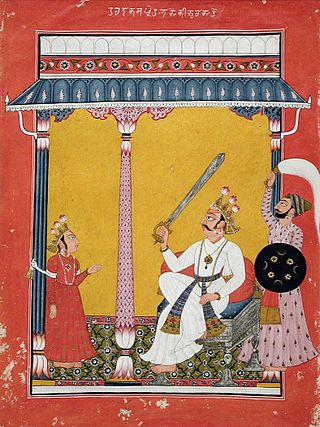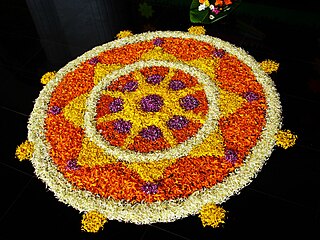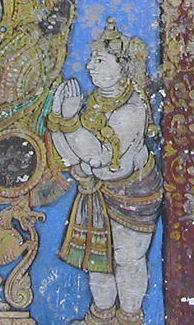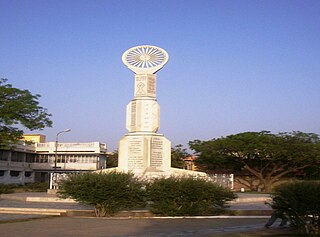Related Research Articles

Narasimha, sometimes rendered Narasingha, is the fourth avatar of the Hindu god Vishnu. He is believed to have incarnated in the form of a part-lion, part-man being to kill Hiranyakashipu, to end religious persecution and calamity on earth, thereby restoring dharma. Narasimha is often depicted with three eyes, and is described in Vaishnavism to be the God of Destruction; he who destroys the entire universe at the time of the great dissolution (Mahapralaya). Hence, he is known as Kala (time) or Mahakala (great-time), or Parakala in his epithets. There exists a matha (monastery) dedicated to him by the name of Parakala Matha at Mysuru in the Sri Vaishnava tradition. Narasimha is also described as the God of Yoga, in the form of Yoga-Narasimha.

Hiranyakashipu, also known as Hiranyakashyap, was a daitya king of the asuras in the Puranas.

Vamana also known as Trivikrama, Urukrama, Upendra, Dadhivamana, and Balibandhana, is an avatar of the Hindu deity Vishnu. He is the fifth avatar of Vishnu and the first Dashavatara in the Satya Yuga, after Narasimha.

Ravana is a multi-headed rakshasa king of the island of Lanka, and the chief antagonist in the Hindu epic Ramayana. In the Ramayana, Ravana is described as the eldest son of sage Vishrava and Kaikasi. He abducted Prince Rama's wife, Sita, and took her to his kingdom of Lanka, where he held her in the Ashoka Vatika. Rama, with the support of vanara King Sugriva and his army of vanaras, launched an invasion against Ravana in Lanka. Ravana was subsequently slain, and Rama rescued his beloved wife Sita.
Avatar is a concept within Hinduism that in Sanskrit literally means 'descent'. It signifies the material appearance or incarnation of a powerful deity, or spirit on Earth. The relative verb to "alight, to make one's appearance" is sometimes used to refer to any guru or revered human being.

Onam is an annual harvest and cultural festival related to Hinduism that is celebrated mostly by the people of Kerala. A major annual event for Keralites, it is the official festival of the state and includes a spectrum of cultural events.

Holi is a popular and significant Hindu festival celebrated as the Festival of Colours, Love, and Spring. It celebrates the eternal and divine love of the deities Radha and Krishna. Additionally, the day signifies the triumph of good over evil, as it commemorates the victory of Vishnu as Narasimha over Hiranyakashipu. Holi originated and is predominantly celebrated in the Indian subcontinent of India and Nepal, but has also spread to other regions of Asia and parts of the Western world through the Indian diaspora.

Bhakta Prahlada is a 1967 Indian Telugu-language Hindu mythological film directed by Chitrapu Narayana Rao based on a script by D. V. Narasa Raju. It stars S. V. Ranga Rao and Anjali Devi. Roja Ramani, in her film debut, plays the title character. Bhakta Prahlada is produced on the AVM Productions banner by A. V. Meiyappan and his sons, M. Murugan, M. Kumaran and M. Saravanan. The film is based on the legend of Prahlada, a character in Bhagavata Purana known for his devotion to the Hindu god Vishnu.

Gandaberunda is a two-headed bird and he is a form of the Hindu god Vishnu as Narasimha and he has enormous powers in Hindu mythology. In Hinduism, Gandaberunda is a form of Vishnu as Narasimha who disemboweled and killed Sharabha, a form of Shiva and Hiranyakashipu at the same time in Hindu mythology.
Vishnu Puran is an Indian television series, by B. R. Chopra on the Hindu deity Vishnu. It is based on the Bhagavata Purana. Bhagavata Purana tells about the 10 incarnations of Vishnu, as well as other stories, such as the legend of Dhruva. The weekly series first aired Sunday morning, 23 January 2000 on Zee TV. The 124 episodes were later released on DD National.
The Dashavatara are the ten primary avatars of Vishnu, a principal Hindu god. Vishnu is said to descend in the form of an avatar to restore cosmic order. The word Dashavatara derives from daśa, meaning "ten", and avatāra, roughly equivalent to "incarnation".
Hari Darshan is a 1972 Bollywood religious film directed by Chandrakant. The film stars Dara Singh & other artists of Indian film Industry, who portray different characters during the time of Bhakt Prahlad. The story revolves around the devotee Prahlad. It also show cases different Avtars (incarnations) of lord Shri Hari Vishnuji.

Prahlada is an asura king in Hindu mythology. He is known for his staunch devotion to the preserver deity, Vishnu. He appears in the narrative of Narasimha, the lion avatara of Vishnu, who rescues Prahlada by killing his wicked father, Hiranyakashipu.

Mehtab (1913–1997) was an Indian actress of Hindi/Urdu films who worked from 1928 to 1969. She was born in Sachin, Gujarat, to a Muslim family and named Najma. Her father, Nawab Sidi Ibrahim Mohammad Yakut Khan III, was the Nawab of Sachin, near Surat in the state of Gujarat. Starting her career in the late 1920s with small roles in films like Second Wife (1928), Indira B. A. (1929) and Jayant (1929), she went on to do character roles before acting in the lead opposite Ashraf Khan in Veer Kunal (1932). After almost a decade of doing mainly action-oriented roles, she came into prominence with the Kidar Sharma-directed Chitralekha (1941).

Ram Rajya is an Indian 1967 Hindi religious film based on Valmiki's Ramayana and directed by Vijay Bhatt. The film was produced by Shankarbhai Bhatt. The music director was Vasant Desai with lyrics written by Bharat Vyas. The cinematographer was Pravin Bhatt and the film starred Bina Rai, Kumar Sen, Badri Prasad, Kanhaiyalal, Farida dadi, Anil Kumar, Jay Vijay.

Hindaun is a Block in Karauli district of the Indian state of Rajasthan in Northern India. It is a subdivisional headquarter. Its population is approximately 442,000. The block covers an area of 700 Square kilometres, which makes it the biggest block in Karauli. The subdistrict code of Hindaun Block is 00522. There are about 165 villages in Hindaun Block.

Kaun Hai? is an Indian Hindi horror anthology television series produced by Contiloe Entertainment. It premiered 29 June 2018 on Colors TV and ended on 14 October that same year, lasting two seasons.
References
- ↑ Ashish Rajadhyaksha; Paul Willemen; Professor of Critical Studies Paul Willemen (10 July 2014). Encyclopedia of Indian Cinema. Routledge. pp. 284–. ISBN 978-1-135-94318-9 . Retrieved 29 December 2014.
- ↑ "Narsinha Avtar". Gomolo.com. Retrieved 29 December 2014.
- ↑ "Narsimha Avtar". Hindi Geetmala. Retrieved 29 December 2014.
- ↑ "Narsinha Avtar". Alan Goble. Retrieved 29 December 2014.
- 1 2 Gangar, Amrit (2008). Sohrab Modi The Great Mughal of Historicals. New Delhi, India: Wisdom Tree. p. 62. ISBN 9788183281089.
- ↑ "Bhakta Prahlada (1967)". cinegoer.net. Cinegoer.net. Retrieved 29 December 2014.
- ↑ "Songs-Narsinha Avtar". Muvyz, Inc. Retrieved 29 December 2014.